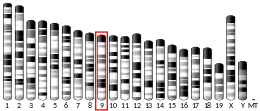MAP4
Microtubule-associated protein 4 is a protein that in humans is encoded by the MAP4 gene.[5]
The protein encoded by this gene is a major non-neuronal microtubule-associated protein. This protein contains a domain similar to the microtubule-binding domains of neuronal microtubule-associated protein (MAP2) and microtubule-associated protein tau (MAPT/TAU). This protein promotes microtubule assembly, and has been shown to counteract destabilization of interphase microtubule catastrophe promotion. Cyclin B was found to interact with this protein, which targets cell division cycle 2 (CDC2) kinase to microtubules. The phosphorylation of this protein affects microtubule properties and cell cycle progression. Multiple alternatively spliced transcript variants encoding distinct isoforms have been observed, the full-length nature of three of which are supported.[6] uMAP4, the ubiquitous isoform of MAP4, functions in the architecture and positioning of the mitotic spindle in human cells.[7] oMAP4 is predominantly expressed in brain and muscle and has been shown to organise microtubules into antiparallel bundles.[8] mMAP4 is a muscle-specific isoform.[8][9]
References
- GRCh38: Ensembl release 89: ENSG00000047849 - Ensembl, May 2017
- GRCm38: Ensembl release 89: ENSMUSG00000032479 - Ensembl, May 2017
- "Human PubMed Reference:". National Center for Biotechnology Information, U.S. National Library of Medicine.
- "Mouse PubMed Reference:". National Center for Biotechnology Information, U.S. National Library of Medicine.
- Chapin SJ, Bulinski JC (Jul 1991). "Non-neuronal 210 x 10(3) Mr microtubule-associated protein (MAP4) contains a domain homologous to the microtubule-binding domains of neuronal MAP2 and tau". J Cell Sci. 98. ( Pt 1): 27–36. PMID 1905296.
- "Entrez Gene: MAP4 microtubule-associated protein 4".
- Samora, Catarina P.; Mogessie, Binyam; Conway, Leslie; Ross, Jennifer L.; Straube, Anne; McAinsh, Andrew D. (7 August 2011). "MAP4 and CLASP1 operate as a safety mechanism to maintain a stable spindle position in mitosis". Nature Cell Biology. 13 (9): 1040–1050. doi:10.1038/ncb2297. PMID 21822276. S2CID 8869880.
- Mogessie, Binyam; Roth, Daniel; Rahil, Zainab; Straube, Anne (21 April 2015). "A novel isoform of MAP4 organises the paraxial microtubule array required for muscle cell differentiation". eLife. 4: e05697. doi:10.7554/eLife.05697. PMC 4423121. PMID 25898002.
- Casey, LM; Lyon, HD; Olmsted, JB (April 2003). "Muscle-specific microtubule-associated protein 4 is expressed early in myogenesis and is not sufficient to induce microtubule reorganization". Cell Motility and the Cytoskeleton. 54 (4): 317–36. doi:10.1002/cm.10105. PMID 12601693.
Further reading
- Chapin SJ, Bulinski JC (1993). "Microtubule stabilization by assembly-promoting microtubule-associated proteins: a repeat performance". Cell Motil. Cytoskeleton. 23 (4): 236–43. doi:10.1002/cm.970230403. PMID 1477887.
- West RR, Tenbarge KM, Olmsted JB (1991). "A model for microtubule-associated protein 4 structure. Domains defined by comparisons of human, mouse, and bovine sequences". J. Biol. Chem. 266 (32): 21886–96. PMID 1718985.
- Chapin SJ, Lue CM, Yu MT, Bulinski JC (1995). "Differential expression of alternatively spliced forms of MAP4: a repertoire of structurally different microtubule-binding domains". Biochemistry. 34 (7): 2289–301. doi:10.1021/bi00007a025. PMID 7857940.
- Ookata K, Hisanaga S, Bulinski JC, et al. (1995). "Cyclin B interaction with microtubule-associated protein 4 (MAP4) targets p34cdc2 kinase to microtubules and is a potential regulator of M-phase microtubule dynamics". J. Cell Biol. 128 (5): 849–62. doi:10.1083/jcb.128.5.849. PMC 2120387. PMID 7876309.
- Chapin SJ, Bulinski JC (1994). "Cellular microtubules heterogeneous in their content of microtubule-associated protein 4 (MAP4)". Cell Motil. Cytoskeleton. 27 (2): 133–49. doi:10.1002/cm.970270205. PMID 7909279.
- Andersson B, Wentland MA, Ricafrente JY, et al. (1996). "A "double adaptor" method for improved shotgun library construction". Anal. Biochem. 236 (1): 107–13. doi:10.1006/abio.1996.0138. PMID 8619474.
- Illenberger S, Drewes G, Trinczek B, et al. (1996). "Phosphorylation of microtubule-associated proteins MAP2 and MAP4 by the protein kinase p110mark. Phosphorylation sites and regulation of microtubule dynamics". J. Biol. Chem. 271 (18): 10834–43. doi:10.1074/jbc.271.18.10834. PMID 8631898.
- Yu W, Andersson B, Worley KC, et al. (1997). "Large-scale concatenation cDNA sequencing". Genome Res. 7 (4): 353–8. doi:10.1101/gr.7.4.353. PMC 139146. PMID 9110174.
- Bulinski JC, McGraw TE, Gruber D, et al. (1998). "Overexpression of MAP4 inhibits organelle motility and trafficking in vivo". J. Cell Sci. 110. ( Pt 24): 3055–64. PMID 9365275.
- Ookata K, Hisanaga S, Sugita M, et al. (1998). "MAP4 is the in vivo substrate for CDC2 kinase in HeLa cells: identification of an M-phase specific and a cell cycle-independent phosphorylation site in MAP4". Biochemistry. 36 (50): 15873–83. doi:10.1021/bi971251w. PMID 9398320.
- Nguyen HL, Gruber D, Bulinski JC (1999). "Microtubule-associated protein 4 (MAP4) regulates assembly, protomer-polymer partitioning and synthesis of tubulin in cultured cells". J. Cell Sci. 112. ( Pt 12): 1813–24. PMID 10341201.
- Ebneth A, Drewes G, Mandelkow EM, Mandelkow E (2000). "Phosphorylation of MAP2c and MAP4 by MARK kinases leads to the destabilization of microtubules in cells". Cell Motil. Cytoskeleton. 44 (3): 209–24. doi:10.1002/(SICI)1097-0169(199911)44:3<209::AID-CM6>3.0.CO;2-4. PMID 10542369.
- Kitazawa H, Iida J, Uchida A, et al. (2000). "Ser787 in the proline-rich region of human MAP4 is a critical phosphorylation site that reduces its activity to promote tubulin polymerization". Cell Struct. Funct. 25 (1): 33–9. doi:10.1247/csf.25.33. PMID 10791892.
- Chang W, Gruber D, Chari S, et al. (2002). "Phosphorylation of MAP4 affects microtubule properties and cell cycle progression". J. Cell Sci. 114 (Pt 15): 2879–87. PMID 11683421.
- Iida J, Itoh TJ, Hotani H, et al. (2002). "The projection domain of MAP4 suppresses the microtubule-bundling activity of the microtubule-binding domain". J. Mol. Biol. 320 (1): 97–106. doi:10.1016/S0022-2836(02)00402-3. PMID 12079337.
- Holmfeldt P, Brattsand G, Gullberg M (2002). "MAP4 counteracts microtubule catastrophe promotion but not tubulin-sequestering activity in intact cells". Curr. Biol. 12 (12): 1034–9. doi:10.1016/S0960-9822(02)00897-7. PMID 12123579. S2CID 8816838.
- Strausberg RL, Feingold EA, Grouse LH, et al. (2003). "Generation and initial analysis of more than 15,000 full-length human and mouse cDNA sequences". Proc. Natl. Acad. Sci. U.S.A. 99 (26): 16899–903. doi:10.1073/pnas.242603899. PMC 139241. PMID 12477932.
- Tokuraku K, Matsushima K, Matui T, et al. (2003). "The number of repeat sequences in microtubule-associated protein 4 affects the microtubule surface properties". J. Biol. Chem. 278 (32): 29609–18. doi:10.1074/jbc.M302186200. PMID 12773533.
- Mangan ME, Olmsted J (1996). "The gene for microtubule-associated protein 4 (Mtap4) maps to the distal region of mouse chromosome 9". Mamm. Genome. 7 (12): 918–19. doi:10.1007/s003359900270. PMID 8995766. S2CID 43334937.



